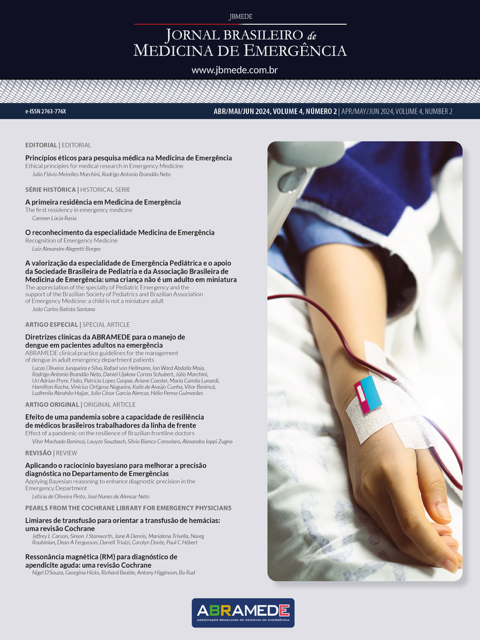Applying Bayesian reasoning to enhance diagnostic precision in the Emergency Department
Main Article Content
Abstract
Emergency medicine demands prompt, decisive actions, often contingent on diagnostic tests. However, the reliance on diagnostic tests, despite their ostensible precision, can sometimes lead to suboptimal outcomes. This paper delves into three clinical scenarios that highlight the importance of a judicious, Bayesian approach in medical practice. The first scenario focuses on a patient with chest pain and a low pre-test probability of pulmonary embolism but a positive imaging result. The second scenario addresses the misleading absence of ST-segment elevation on the electrocardiogram, providing a false negative result of myocardial infarction. The third clinical scenario involves a patient with wide QRS tachycardia. The scenarios underscore that while diagnostic tests are instrumental, they should not eclipse clinical judgment. The overreliance on diagnostics can lead to misdiagnoses, therapeutic failure and/or inadequate treatment of the patient. In the era of evidence-based medicine, the amalgamation of clinical experience, current evidence, and patient values is paramount. This discourse advocates blending clinician intuition with probabilistic reasoning, thereby optimizing decision-making and enhancing patient welfare. Emergency practitioners are urged to harness both their experiential acumen and the Bayesian approach to achieve the best patient outcomes.
Article Details

This work is licensed under a Creative Commons Attribution 4.0 International License.
References
Baethge C, Goldbeck-Wood S, Mertens S. SANRA-a scale for the
quality assessment of narrative review articles. Res Integr Peer
Rev. 2019;4:5.
Natesan S, Bailitz J, King A, Krzyzaniak SM, Kennedy SK, Kim AJ,
et al. Clinical Teaching: An Evidence-based Guide to Best Practices
from the Council of Emergency Medicine Residency Directors.
West J Emerg Med. 2020;21(4):985-98.
Patel P, Patel P, Bhatt M, Braun C, Begum H, Wiercioch W, et al.
Systematic review and meta-analysis of test accuracy for the
diagnosis of suspected pulmonary embolism. Blood Advances.
;4(18):4296-311.
Altman DG, Bland JM. Diagnostic tests. 1: Sensitivity and
specificity. BMJ. 1994;308(6943):1552.
Moons KG, Harrell FE. Sensitivity and specificity should be
de-emphasized in diagnostic accuracy studies. Acad Radiol.
;10(6):670-2.
Croskerry P. From mindless to mindful practice – cognitive bias
and clinical decision making. N Engl J Med. 2013;368(26):2445-8.
O’Sullivan ED, Schofield SJ. Cognitive bias in clinical medicine.
The journal of the Royal College of Physicians of Edinburgh.
;48(3):225-32.
Ashby D, Smith AF. Evidence-based medicine as Bayesian decisionmaking.
Stat Med. 2000;19(23):3291-305.
Binder K, Krauss S, Schmidmaier R, Braun LT. Natural frequency
trees improve diagnostic efficiency in Bayesian reasoning. Adv
Health Sci Educ Theory Pract. 2021;26(3):847-63.
Deeks JJ, Altman DG. Diagnostic tests 4: likelihood ratios. BMJ.
;329(7458):168-9.
McDowell M, Jacobs P. Meta-analysis of the effect of natural
frequencies on Bayesian reasoning. Psychological Bulletin.
;143(12):1273-312.
Fagan TJ. Letter: Nomogram for Bayes’s theorem. N Engl J Med.
;293(5):257.
Wells PS, Anderson DR, Rodger M, Stiell I, Dreyer JF, Barnes
D, et al. Excluding pulmonary embolism at the bedside without
diagnostic imaging: management of patients with suspected
pulmonary embolism presenting to the emergency department
by using a simple clinical model and d-dimer. Ann Intern Med.
;135(2):98-107.
Wolf SJ, McCubbin TR, Feldhaus KM, Faragher JP, Adcock DM.
Prospective validation of Wells Criteria in the evaluation of
patients with suspected pulmonary embolism. Ann Emerg Med.
;44(5):503-10.
Meyers HP, Bracey A, Lee D, Lichtenheld A, Li WJ, Singer DD, et al.
Accuracy of OMI ECG findings versus STEMI criteria for diagnosis
of acute coronary occlusion myocardial infarction. Int J Cardiol
Heart Vasc. 2021;33:100767.
Vasile VC, Jaffe AS. High-sensitivity cardiac troponin for the
diagnosis of patients with acute coronary syndromes. Curr Cardiol
Rep. 2017;19(10):92.
Wereski R, Chapman AR, Lee KK, Smith SW, Lowe DJ, Gray A, et al.
High-sensitivity cardiac troponin concentrations at presentation
in patients with st-segment elevation myocardial infarction. JAMA
Cardiol. 2020;5(11):1302-4.
Wanamaker BL, Seth MM, Sukul D, Dixon SR, Bhatt DL, Madder
RD, et al. Relationship between troponin on presentation and
in-hospital mortality in patients with ST-segment-elevation
myocardial infarction undergoing primary percutaneous coronary
intervention. J Am Heart Assoc. 2019;8(19):e013551.
Al-Khatib SM, Stevenson WG, Ackerman MJ, Bryant WJ,
Callans DJ, Curtis AB, et al. 2017 AHA/ACC/HRS guideline for
management of patients with ventricular arrhythmias and the
prevention of sudden cardiac death: a report of the American
College of Cardiology/American Heart Association Task Force on
Clinical Practice Guidelines and the Hea. Journal of the American
College of Cardiology. 2018;72(14):e91-220.
Vereckei A, Duray G, Szenasi G, Altemose GT, Miller JM. New
algorithm using only lead aVR for differential diagnosis of wide
QRS complex tachycardia. Heart Rhythm. 2008;5(1):89-98.
Baerman JM, Morady F, DiCarlo LA, de Buitleir M. Differentiation
of ventricular tachycardia from supraventricular tachycardia
with aberration: value of the clinical history. Ann Emerg Med.
;16(1):40-3.
de Alencar Neto JN. Applying Bayesian reasoning to
electrocardiogram interpretation. J Electrocardiol. 2023;81:295-9.
Simpkin AL, Schwartzstein RM. Tolerating Uncertainty - The Next
Medical Revolution? N Engl J Med. 2016;375(18):1713-5.
Kassirer JP. Our stubborn quest for diagnostic certainty. A cause
of excessive testing. N Engl J Med. 1989;320(22):1489-91.

